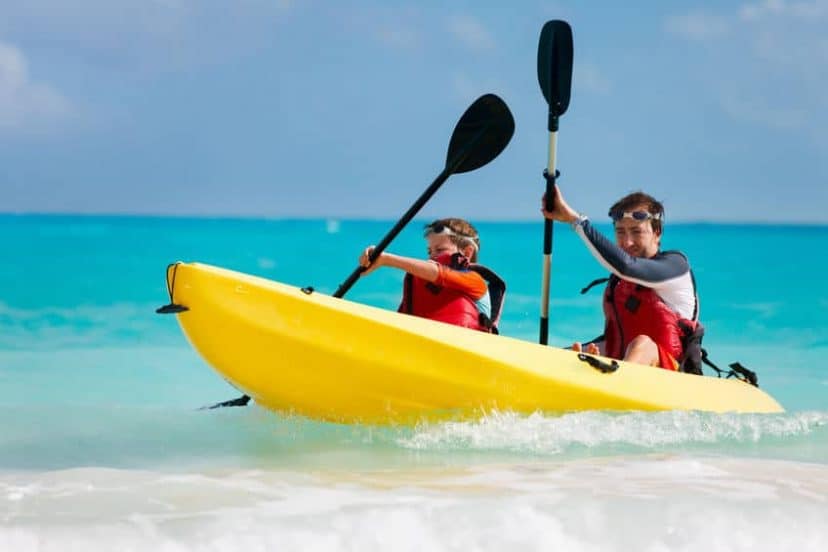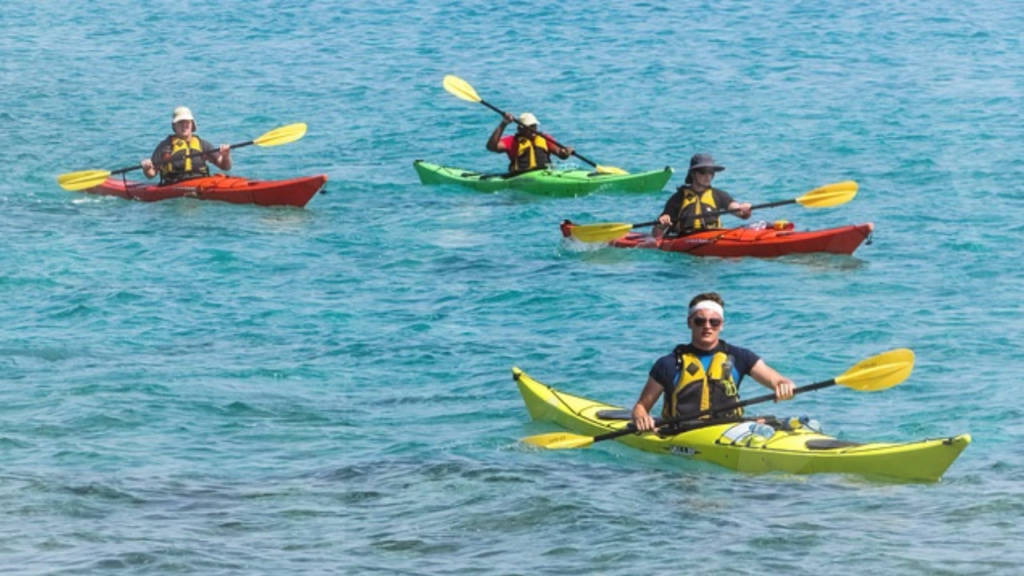While you should not exceed the kayak weight limit, you should still be able to carry a lot of gear in it. In addition to taking a lot of equipment, you should also keep your kayak weight below 70 percent of its rated capacity. Overloading a kayak will cause poor performance, and it is also hard to control an unbalanced kayak. The weight limit on a kayak is only one of the essential considerations.

You can find the kayak weight limit on the manufacturer’s website. You can also read user reviews and forums that discuss this matter. Most kayakers multiply the advertised weight limit by 0.25%, but some people even recommend adding another 50 percent. Regardless of weight, it is essential to stay within the stated weight limit. As mentioned, there are no absolute rules about how much weight can be put in a kayak. The ideal kayak weight limit is 25 to 30 percent below the maximum capacity.
There are several things to consider when selecting a kayak, but one of the most important is the weight limit. If the kayak is too light, it will capsize if the weight shifts. It will be difficult to control if it is too heavy, and you will feel uncomfortable. It will also be difficult to paddle, and you will also find it painful and difficult to move around in it. If you exceed the kayak weight limit, you may end up sitting at the same level as the waterline.

Once you know the weight limit, you can go shopping for a kayak. You can find a kayak with a weight limit of 500 pounds, and the 350-pound weight limit is 70% of the maximum weight capacity. This will give you plenty of room for more weight and still perform optimally. It’s important to remember that a kayak is made to hold the weight of its user, not just its weight. If you plan to use it for fishing or tandem paddling, you should consider the total capacity of the vessel.
A kayak’s weight limit is the maximum weight that it can hold. A kayak with a weight limit of 500 pounds can be quickly sunk by a prominent person. The maximum weight of a kayak is determined by the size of the cockpit and the overall capacity. If the kayak weighs more than that, it will have difficulty maintaining a stable position and will sink into the water. Hence, the weight limit should be at least 50 percent of the kayak’s weight.
The weight limit of a kayak should be higher than the actual weight of its owner. The maximum weight limit of a kayak should be about 125 pounds above the actual weight of the user. For safety reasons, you should never exceed this limit. A boat with a weight limit of 250 pounds should not be used by more than 250 pounds. The maximum weight limit of a kayak will cause instability and reduced maneuverability. So, you should check the manufacturers’ weight limit of a kayak before you buy it.
The weight limit is the maximum weight that the kayak can support. If the weight limit is too high, the kayak will sink and not float properly. Besides, it will be unstable and may not even swim in shallow water. If you exceed this weight limit, you may also end up with a capsized kayak. A faulty kayak can sink or become inoperable due to the weight. It is, therefore, necessary to check the weight limit of a kayak before buying.

kayak weight capacity
You enjoy kayaking. You may want to possess or rent a kayak to enjoy your trips. However, when buying the kayak, you have many things to think about. One of the factors is the capacity to carry the weight (also called the weight limit) of the kayak. Each kayak comes with a weight limit. A typical recreational kayak can be used with a 250-300 pounds weight limit. A touring (sea) kayaks have 350 pounds limit, a sit-on-top kayak has an upper limit of 350-400 pounds, and tandem kayaks have an upper limit of 500-600 pounds. SO WHAT IS MEANT BY A KAYAK’S WEIGHT LIMIT?

The weight limit for kayaks is the “number given to a vessel by a manufacturer to aid paddlers in determining what kind of kayak is best for them. This also lets paddlers know what equipment and gear they can carry on a vessel. The kayak’s capacity is indicated on every kayak that is made. However, because of the lack of a standard for determining the ability of kayaks to carry, each manufacturer goes through it in their style, which can confuse kayakers.
The weight limit for kayaks is the amount that the boat can support and still float. For instance, if a kayak has a weight maximum of 250lbs, that means that the vessel will flounder a bit on the water’s surface even though it is carrying a weight of 250 pounds. Since the kayak will be able to float just a bit when carrying a load equal to the weight limit, it’ll decrease its stability and maneuverability when loaded to this degree. This is why it’s crucial to never pack a kayak beyond the maximum weight.
PADDLER SIZE TO WEIGHT LIMIT
The weight limit for the kayak is the amount of weight it can support and remain floatable. If a kayak is listed with an official capability of 350 pounds, that doesn’t mean that the person who weighs 350 pounds can use it. For a sit-on-top kayak, the kayak would be in the waterline with most of it below the water, and you’re not going to paddle it. When you are given a maximum weight is stated in the kayak, the capacity of the paddler the kayak may not be the exact weight limit, but always a minimum of 30 to 35 percent of the ability, which would provide an appropriate safety zone. If the maximum weight is 350 pounds, the maximum paddler’s ideal weight for the kayak would be around 262.6 grams or lower. That is only the case if the paddler isn’t carrying any equipment. If, however, clothing, shoes, equipment and other accessories are also included in the equation, then the maximum load for the vessel is approximately 300 pounds.
DOES THE WEIGHT LIMIT MEAN A DRY BOAT?
While it is possible to achieve the safe zone with paddling with a weight 25-30 percent lower than the weight limit for kayaks, it doesn’t mean the kayak will be dry, simple and effective. If you’re looking for less water going through the scuppers and experience more efficient paddling, that is, the kayak going more quickly with each stroke, you’ll have to use a paddler weight that is around 50% from the maximum weight of your kayak. For example, if you wish to stay dry and have a great time paddling on a 350-pound weight limit kayak, the total amount it could carry is 150 pounds, which includes around 25 pounds of gear.

GOING FOR A KAYAK WITH THE RIGHT WEIGHT LIMIT
When purchasing a kayak, you must know the weight of your kayak and the weight of the equipment and gear you plan to take on your journey. Since the weight limit on the boat indicates the maximum load it can carry, the best amount of weight is that which has enough space for the paddler and equipment and gear. When you decide to purchase a kayak, think about buying a kayak with an appropriate weight limit to fit you and the equipment you’re planning to carry. If, for instance, your weight is 295 pounds, and you plan to take your dog, more incredible along with a rod for fishing, you need to find a boat that has an upper limit of 350 pounds. It is recommended to keep your weight below 70% of the maximum capacity of the kayak (including the equipment and other accessories) since overloading a kayak will result in poor performance. In the same way, the distribution of weight is just as crucial in the same way as the limit on weight because if the kayak is imbalanced, it’s harder to manage.
As a rule of thumb, the weight limit of a kayak is about 30 to 35 pounds less than the manufacturer’s stated maximum weight capacity. This should provide a buffer zone for the kayak’s weight as a whole. While a more significant number may be acceptable for one person, a higher one might not be the best choice for you. Likewise, a lighter weight limit will make your kayak more efficient. And a heavier weight limit will also prevent your kayak from tipping over.
Different kayaks have limits that differ.
Kayaks are available in various sizes and shapes and have different weight ratings. There are various widths, lengths, and volumes based on several types of kayaks, and the kind of water the kayak was designed for, such as whitewater or touring.
The various types of kayaks comprise among the following
- Sit on the top kayaks ( click here for more details on sitting in top kayaks)
- Sit inside kayaks
- The fishing kayaks ( click here to find out more about fishing kayaks)
- Inflatable kayaks
- Tandem kayaks
Within the categories of each, kayak weight limits vary. There are a few exceptions. Not all sit-on-top kayaks are the same in weight, similar to other kinds of kayaks.
Kayak weight limits vary by manufacturer.
Every boat manufacturer sets the weight limit, but there isn’t a strict and unchanging rule of thumb for accomplishing this. Every manufacturer has a weight limit according to specific requirements. A second thing to consider is that just because you shell out more money for kayaks doesn’t mean you’ll automatically gain greater weight capacity.
Some manufacturers have the maximum capacity and a “working” capacity. Imagine”working” capacity as the “working” capacity as the maximum weight that the boat can carry and maintain its efficiency.
How to determine kayak weight limit
There’s some clarity in the confusion of kayak weight capacity, and it’s not difficult to accomplish so long as you are willing to do a bit of math. I’m not a maths person. However, I am blessed with an iPhone with a calculator, which means I can complete this.
The weight limit you need to be aware of is approximately two-thirds of the maximum capacity. If you’re considering an inflatable kayak that has a maximum weight of 300 pounds cut 100 pounds off (1/3), then you’ll have a load of 200 pounds capacity. The 600-pound kayak weight limit would give you around 400lbs of weight capacity.
It doesn’t mean that you need to choose a kayak with the highest weight limit. It’s more of a guideline. If you’re a 200-pound man, you must be aware of your body weight as well as the equipment you’ll be taking along. If you plan to carry a kayak cooler packed with ice and drinks, or perhaps you own an anchor for your kayak to fish, be aware of how that all of this gear is worth it.
The way you’ll use your kayak (camping, fishing or just for fun) will determine when it comes to the maximum weight you need to consider.
Kayak stability
As if that wasn’t enough information to get your brain about, here are more ideas for you to consider. In terms of the stability of your kayak, you’ll need the primary stabilization as well as the second stability. The weight of your kayak can impact stability.
The primary stabilization is what people who are just beginning kayaking imagine when they think of the stability. When sitting in a kayak and leaning from slightly to one side, you might feel relatively steady. This refers to strength in the immediate sense, the same way you think lying on flat or calm water. You may be flipped over if you are leaning too much but not enough.
Secondary stability is how the vessel reacts when it’s in a trough or leaning to one side. This is especially evident when you’re in turbulent conditions at sea or in rough water. Even if your load seems secure while you’re loading up and then initially sitting on the shore (primary stability). Still, you could suffer from poor secondary stability when moving in the waters.
A kayak may have good initial stability, and however, you could be in trouble when turbulence begins to set in. This is especially the case if your kayak is laden with water.

Kayak weight limit examples
Here are a few examples of various types of kayaks and their weight limitations.
Single
- Pelican Trailblazer NXT 275 lbs
- Lifetime Teton Angler Kayak – 275 pounds
- Vibe Skipjack 90 Kayak – 300 pounds
- Old Town Trip 10 Deluxe Angler Kayak 325 pounds
- Perception Pescador 12.0 Sit-on-Top Kayak – 375 pounds
- Ascend H12 Hybrid – 450 pounds
- Perception Pescador Pilot 12.0 (pedal drive) – 475 pounds
Inflatable kayaks
- Aquaglide Deschutes 130-400 pounds
- BLACKFOOT ANGLER 110 HB – 400 pounds
Tandem
- Ocean Kayak MALIBU TWO – 425 pounds
- Ocean Kayak MALIBU TWO XL ANGLER – 500 pounds
- Perception Tribe 13.5 – 500 pounds
- Perception Rambler 13.5 – 550 pounds
- Brooklyn Kayak Co. TK122 Angler 12-foot – 770 pounds
As you can see, there’s an array of kayaks carrying capacity as well as a variety of prices too.
Some points to be noted here are that tandem kayaks can support the greater weight that makes sense. There are two people on board and more gear, which is why they’re designed to handle more. Don’t be deceived by inflatables, and they can carry large loads too.
Conclusion
I believe that a kayak’s weight limit should be based on the amount it can hold. There are numerous aspects to consider when purchasing an inflatable kayak, and it is the limit on the weight that’s at the highest. An excellent place to start is to determine how you intend to use the kayak (camping, fishing, floating, or just floating around lakes), and this will provide you with an idea of the quantity of equipment you’ll need.
You can then narrow your search according to other aspects, such as width, length, accessories, and cost. The weight limit for kayaks is a fascinating issue, and I’m sure you can find exactly what you’re seeking.


